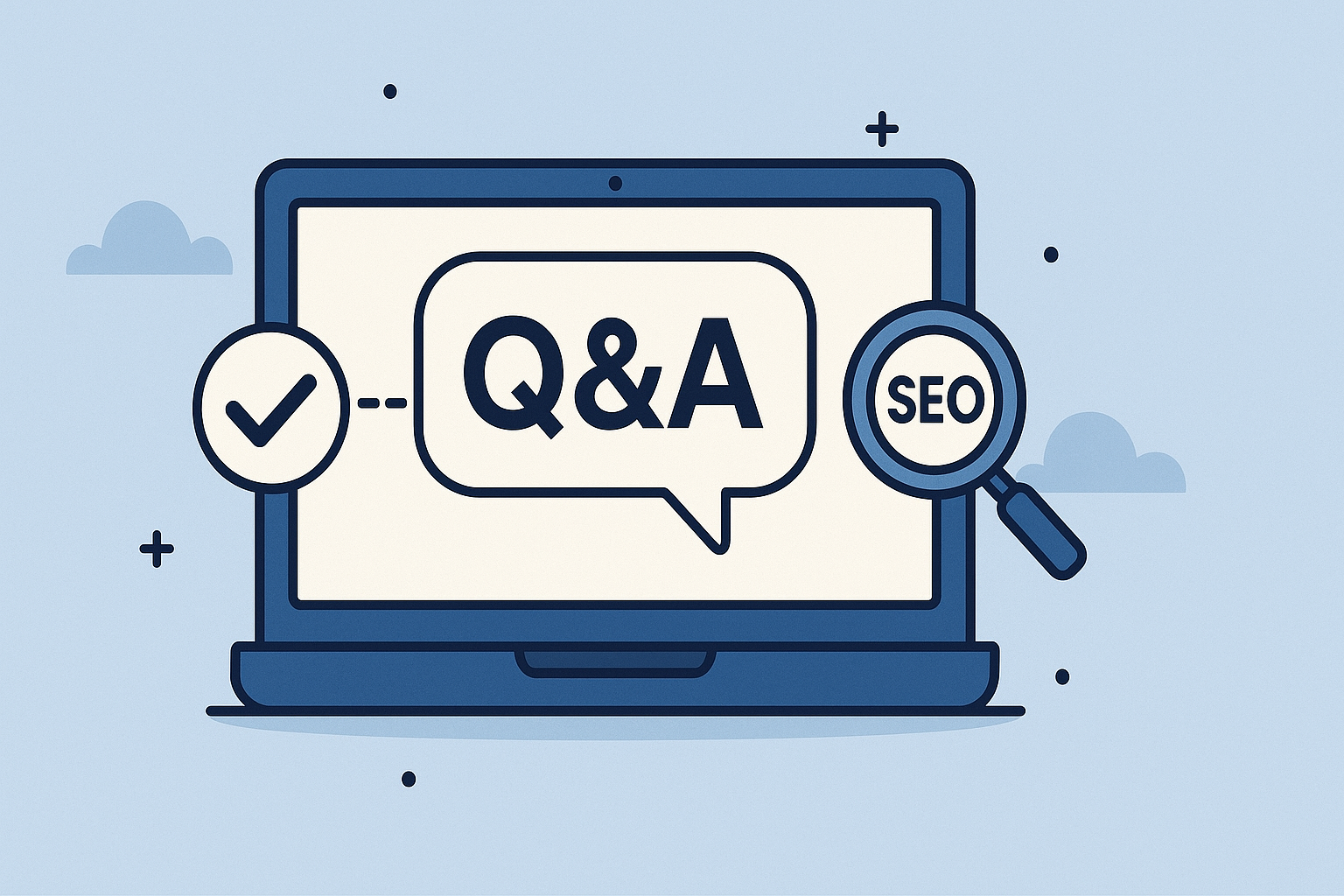Core Web Vitals field vs lab data: SEO guide (2025)

Have you ever noticed that your PageSpeed Insights scores don't match what you see in Google Search Console?
You're not alone. This difference confuses many SEO professionals and can lead to misguided optimization efforts.
The root cause ? Google uses two completely different types of data to measure your site's performance : field data (real user experiences) and lab data (controlled testing environments).
Understanding the difference is essential for effective SEO strategy, and proper Core Web Vitals optimization.
In this guide, I'll break down exactly what each type of data means, why they differ, and most importantly, how to use both effectively in your SEO workflow to improve your rankings and user experience.
The basics: what are field data and lab data?
Before diving into optimization strategies, let's establish what we're measuring when we talk about Core Web Vitals performance data.
Field data: real user monitoring (RUM)
Field data represents the actual browsing experiences of real users visiting your website. Every time someone loads your page using Chrome, their device automatically collects performance metrics and anonymously reports them to Google's Chrome User Experience Report (CrUX).
This data reflects the reality of your users' experiences, including:
- Different device capabilities (high-end laptops vs budget smartphones)
- Various network conditions (fiber connections vs mobile data)
- Geographic locations and their infrastructure quality
- User behavior patterns (immediate scrolling, tab switching, etc.)
Think of field data as a continuous survey of your actual visitors.
It's messy, unpredictable, and varies widely — just like real life 🤷.
This is exactly why Google considers it the authoritative source for ranking purposes.
Lab data: controlled testing environment
Lab data comes from controlled tests run in standardized environments.
When you use tools like PageSpeed Insights, Lighthouse, or run performance audits, you're getting lab data.
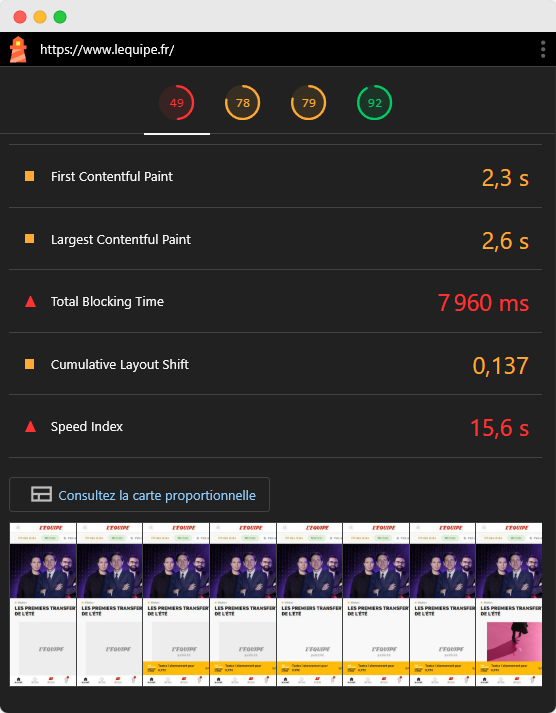
These tests simulate a user experience using:
- Predefined device specifications (usually mid-range mobile and desktop)
- Fixed network conditions (simulated 4G or broadband)
- Consistent testing parameters
- No user interactions or behavior variations
Lab data is like a controlled scientific experiment.
It's reproducible, consistent, and perfect for debugging—but it may not reflect what your real users experience.
Why your field and lab data are different
The discrepancies between field and lab data aren't errors—they're expected and reveal important insights about your site's performance in the real world.
Device and network diversity
Your real users don't all have the same setup as Google's testing servers. Field data includes:
- Budget smartphones with limited processing power and memory
- Slow network connections in rural areas or developing markets
- Older devices that struggle with modern web technologies
- Peak usage times when networks are congested
Meanwhile, lab data typically uses standardized conditions that may be better (or worse) than what your average user experiences.
User behavior impact
Real users behave differently than automated tests:
- They might scroll immediately while content is still loading
- They could switch tabs or apps during page load
- They may have dozens of browser tabs open, affecting performance
- Their devices might be running background apps
Lab tests don't account for these real-world variables, which can significantly impact metrics like Largest Contentful Paint (LCP) and Interaction to Next Paint (INP).
Geographic and infrastructure factors
Field data includes users from different regions with varying infrastructure quality. If you have significant traffic from areas with slower internet or older mobile networks, this will impact your field data scores—something lab tests can't capture.
Understanding the 75th percentile
Here's where many SEO professionals get confused: Google doesn't use average scores for field data. Instead, they use the 75th percentile, and understanding this is crucial for proper optimization.
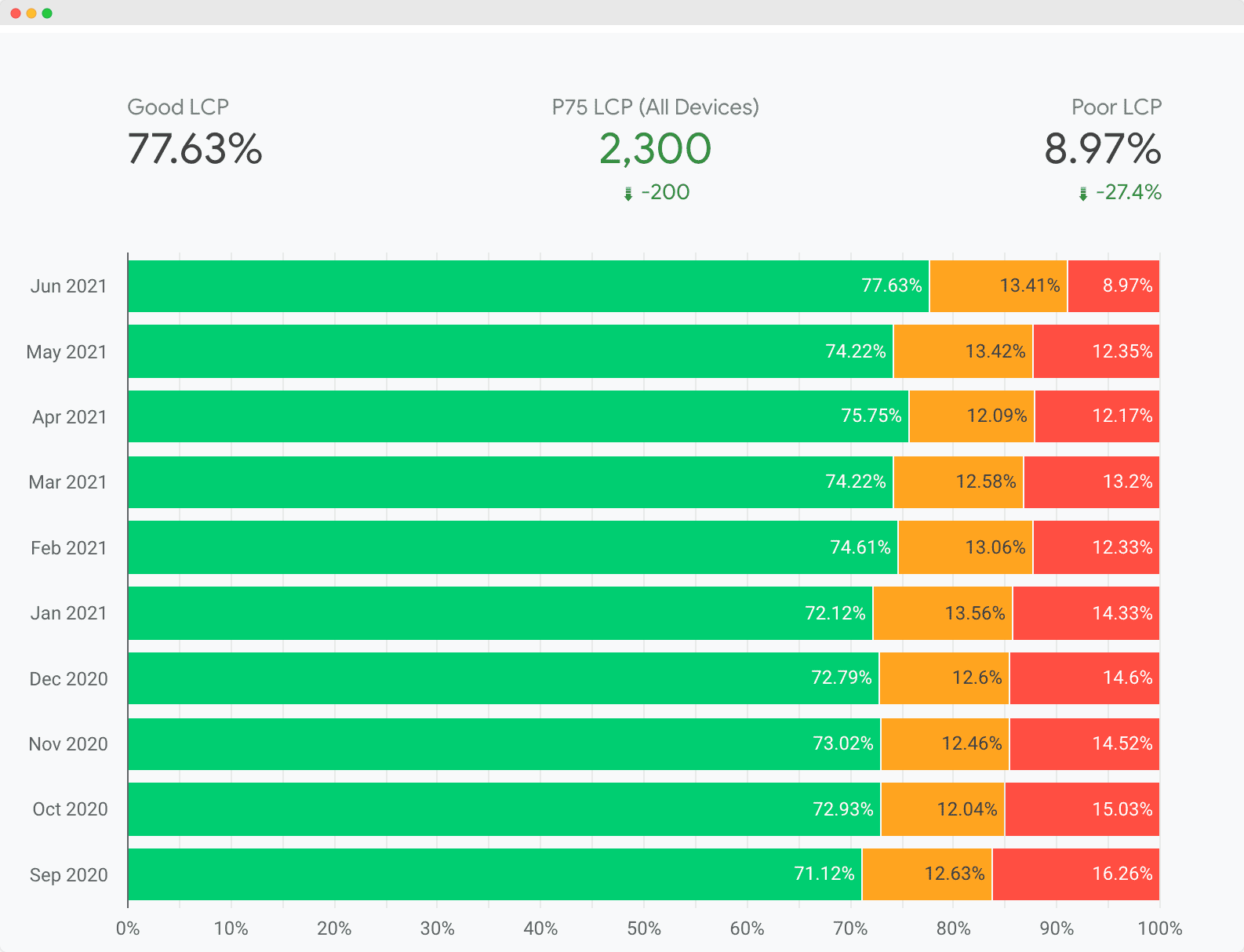
The 75th percentile means that 75% of your users had an experience equal to or better than the reported score. For example, if your field LCP shows 2.1 seconds at the 75th percentile, it means:
- 75% of users experienced LCP of 2.1 seconds or faster
- 25% of users experienced LCP slower than 2.1 seconds
Why does Google use this metric?
Because it balances between typical user experience and outlier protection.
Using the average would allow poor experiences for a significant portion of users to be masked by fast experiences from users with high-end devices. The 75th percentile ensures that the vast majority of users get a good experience.
This is fundamentally different from lab data, which gives you a single data point from one specific test condition.
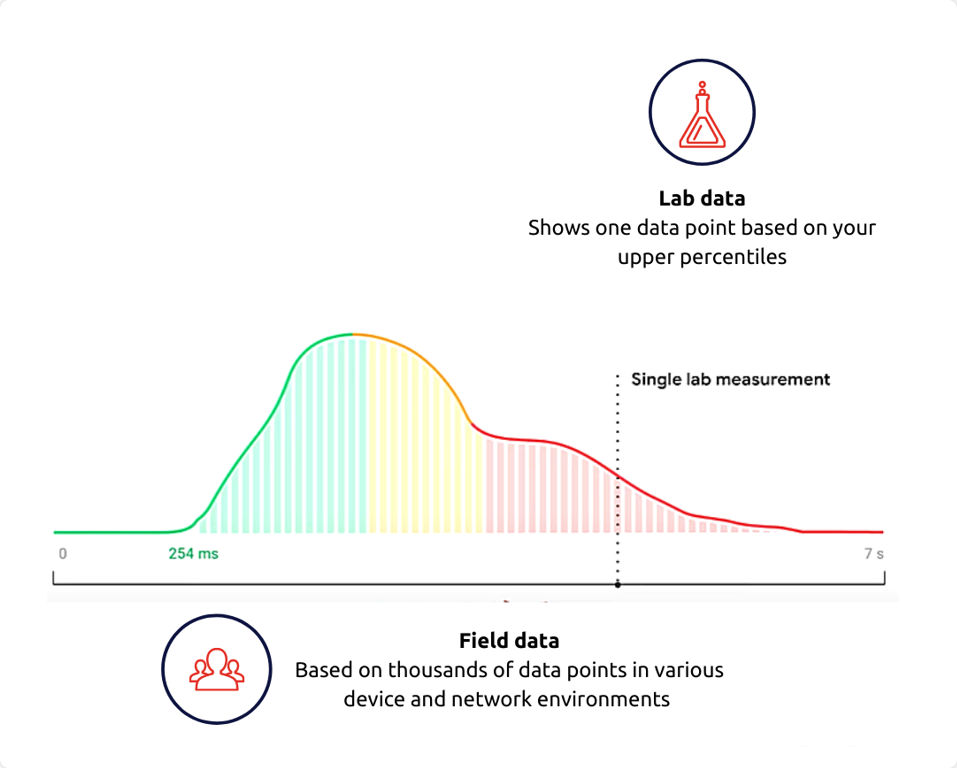
What Google says: field data drives SEO rankings
Google has been crystal clear about which data type matters for search rankings: field data wins, every time.
As confirmed by Google's John Mueller and documented in their official guidance, only field data from the Chrome User Experience Report influences your page experience rankings. Lab data, no matter how good or bad, has zero direct impact on your search visibility.
This makes sense from Google's perspective. They want to rank pages that deliver good experiences to real users, not pages that perform well only under ideal testing conditions. If your site scores perfectly in lab tests but frustrates real users with slow loading, Google considers that a poor user experience.
However, this doesn't mean lab data is useless — quite the opposite. It's an essential tool for identifying and fixing issues before they impact your field data scores.
How to use each data type in your SEO workflow
The most effective Core Web Vitals optimization strategy uses both field and lab data strategically, leveraging each type's strengths while understanding their limitations.
Lab data: your debugging and development tool 🧪
Lab data excels in several key scenarios:
Problem identification and debugging When your field data shows poor performance, lab data helps you understand why. You can run controlled tests to isolate specific issues, test different optimization approaches, and verify that changes work before deploying them to real users.
Pre-deployment testing Before launching new features or design changes, lab tests let you catch performance regressions early. This is especially valuable when integrated into your development workflow or CI/CD pipeline.
Competitive analysis Since lab tests use standardized conditions, they're perfect for comparing your site's performance against competitors on a level playing field.
Quick optimization validation When you implement performance improvements like font optimization or image compression, lab tests provide immediate feedback on whether your changes work.
Field data: your ranking and user experience reality check ⛳
Field data serves different but equally important purposes:
Ranking impact assessment Since Google uses field data for rankings, this is your measure of SEO success. Improvements in field data directly translate to potential ranking benefits.
Real user experience validation Field data tells you whether your optimizations improve the experience for your real users, not just testing environments.
Performance monitoring over time Field data helps you catch performance degradation as it happens in the real world, often before you'd notice it in controlled testing.
Business impact correlation You can correlate field data improvements with business metrics like conversion rates, engagement, and revenue to demonstrate the ROI of performance optimization.
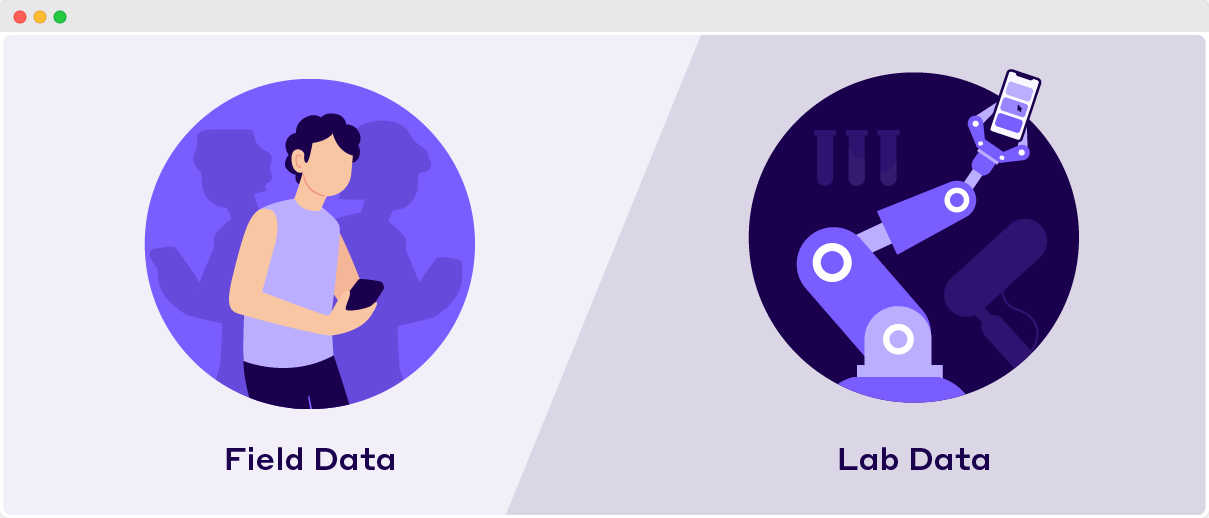
Creating an integrated workflow
The most effective approach combines both data types in a continuous optimization cycle:
- Monitor field data for overall performance trends and ranking impact
- Use lab data to investigate specific issues identified in field data
- Implement optimizations based on lab testing insights
- Validate improvements through continued field data monitoring
- Iterate and refine based on real-world results
Tools like PageRadar make this workflow easy by tracking both field and lab data over time, alerting you to performance degradation, and helping you correlate optimizations with actual user experience improvements.
Practical scenarios: interpreting data discrepancies
Understanding what different field vs lab data combinations mean helps you prioritize optimization efforts effectively.
Scenario 1: good lab data, poor field data
What it means: Your site performs well under ideal conditions but struggles with real-world challenges like slow devices, poor networks, or high traffic loads.
Common causes:
- Heavy JavaScript that overwhelms budget devices
- Large images that slow loading on mobile networks
- Server performance issues during peak traffic
- Third-party scripts causing inconsistent performance
Action steps:
- Focus on mobile optimization and lightweight alternatives
- Implement better caching and CDN strategies
- Optimize for low-end devices specifically
- Consider progressive enhancement approaches
Scenario 2: poor lab data, acceptable field data
What it means: Your site has technical issues that show up in controlled testing, but your real users don't experience these problems as severely.
Common causes:
- Lab test conditions are more stringent than your typical user's setup
- Your audience primarily uses high-end devices
- Geographic concentration in areas with good infrastructure
- Effective caching that benefits returning visitors
Action steps:
- Still worth optimizing, as you may be missing potential users
- Consider the lab data a warning about performance limits
- Test with more realistic user conditions
Scenario 3: missing field data
What it means: Your website don't have enough Chrome users to generate statistically significant field data.
Common causes:
- Low overall traffic volume
- Limited Chrome usage among your audience
- New pages that haven't accumulated enough data
Action steps:
- Rely more heavily on lab data for optimization decisions
- Focus on driving more traffic to improve data collection
- Consider implementing your own RUM solution for better insights
Tools and monitoring: beyond PageSpeed Insights
While PageSpeed Insights is the most familiar tool, effective Core Web Vitals monitoring requires a broader toolkit that tracks both data types over time.
Field data monitoring tools
Google Search Console provides the most authoritative field data since it uses the same CrUX data that impacts rankings. However, it only updates monthly and doesn't provide detailed insights for optimization.
CrUX API and dashboard offer more detailed field data analysis, including filtering by device type and connection speed. This helps you understand which user segments drive your performance scores.
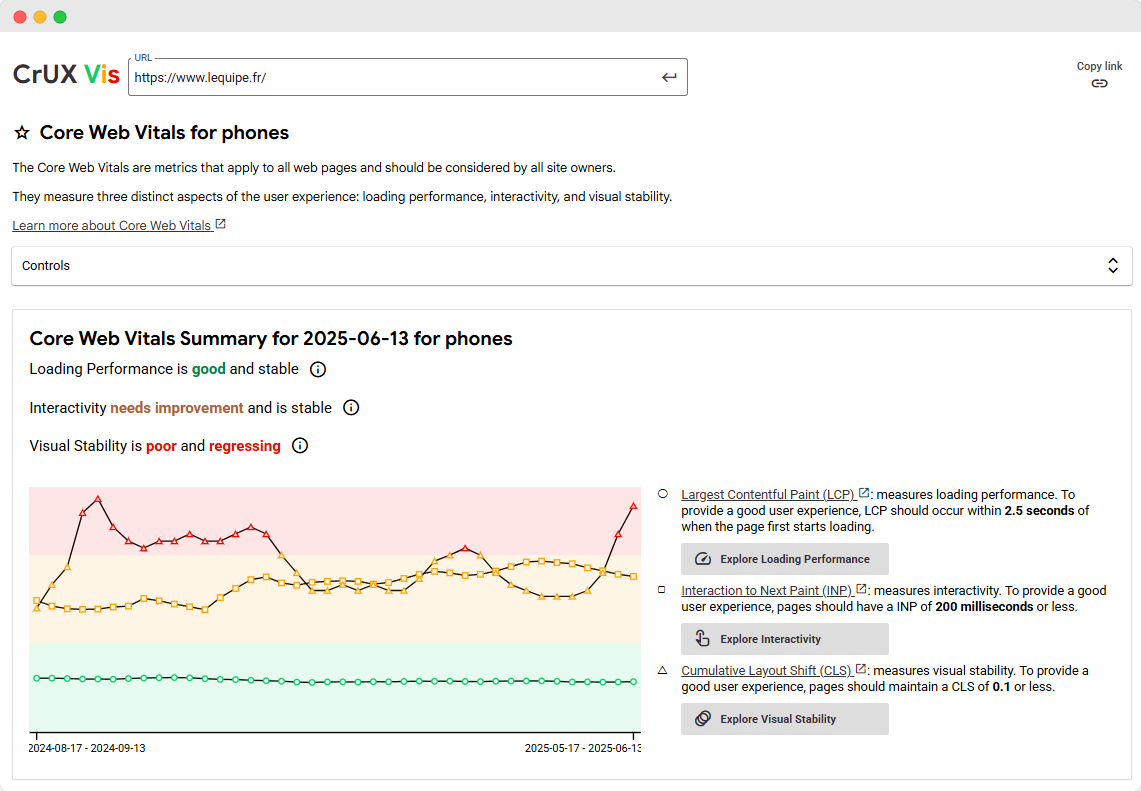
Performance monitoring platforms like PageRadar combine both data types by using the PageSpeed Insights API for lab data and the CrUX API for field data, providing comprehensive tracking with immediate alerts when performance degrades.
This approach gives you both the immediate feedback of lab testing and the ranking-relevant insights of field data in one platform.
Lab data monitoring tools
Lighthouse CLI integrated into your development workflow helps catch performance regressions before they reach production. You can automate these tests to run on every code deployment.
Chrome DevTools provides detailed lab testing with the ability to simulate different devices and network conditions, helping you understand how optimizations impact various user scenarios.
Continuous integration testing automates lab tests as part of your development process, ensuring performance remains a priority throughout the development cycle.
Core Web Vitals monitoring tools comparison
With multiple tools available for measuring Core Web Vitals, choosing the right combination depends on your specific needs. Here's a comprehensive comparison of the most effective tools available in 2025:
| Tool | Type | Frequency | Levels | Best For |
|---|---|---|---|---|
| PageRadar | Field + Lab data | Real-time + Historical data | Site Level and Page Level | Continuous monitoring, alerts, historical trends |
| PageSpeed Insights | Lab and Field data | Shows 28-day average | Page Level | Quick page audits, Google's official tool |
| Google Search Console | Field data | Based on CrUX report | Site Level and Page Level | SEO impact assessment, official ranking data |
| Chrome User Experience Report (CrUX) | Field data | Historical data updated monthly | Site Level and Page Level | Historical performance trends |
| Chrome DevTools | Lab data | Only for the user currently browsing | Page Level | Development debugging, real-time testing |
| Lighthouse | Lab data | Only for the user currently browsing | Page Level | Development workflow, CI/CD integration |
| Web Vitals Chrome Extension | Field data | Only for the user currently browsing | Page Level | Quick on-page testing, development |
| WebPageTest | Lab data | On-demand testing | Page Level | Detailed performance analysis, waterfall charts |
| GTmetrix | Lab data | On-demand testing | Page Level | Performance reports, monitoring alerts |
The key is combining tools strategically: use lab data tools for development and debugging, field data tools for understanding real user impact, and comprehensive monitoring platforms like PageRadar for ongoing optimization.
The importance of continuous monitoring
Performance isn't a one-time optimization—it's an ongoing process. Websites naturally accumulate performance debt through:
- New features and content additions
- Third-party script updates
- Infrastructure changes
- Traffic pattern shifts
PageRadar specializes in this continuous monitoring approach, tracking both field and lab data over time to help you:
- Catch performance degradation before it impacts rankings
- Correlate performance changes with business metrics
- Receive alerts when Core Web Vitals thresholds are exceeded
- Track the real-world impact of optimization efforts
Conclusion: making data-driven performance decisions
Understanding the difference between field and lab data transforms how you approach Core Web Vitals optimization. Instead of chasing perfect lab scores that may not reflect reality, you can focus on improvements that actually benefit your users and rankings.
The key takeaways for effective performance optimization:
Field data is your north star for SEO impact, but lab data is essential for understanding and fixing issues. Both types provide valuable but different insights that complement each other in a comprehensive optimization strategy.
The 75th percentile matters because it ensures the majority of your users get a good experience, not just those with premium devices and connections. This metric balances user experience quality with realistic performance expectations.
Continuous monitoring beats periodic testing because performance changes over time through content updates, traffic growth, and infrastructure evolution. Regular monitoring helps you maintain good Core Web Vitals scores consistently.
By leveraging both field and lab data effectively, you can create a performance optimization strategy that improves both user experience and search rankings. The goal isn't perfect scores in controlled conditions—it's delivering consistently good experiences to your real users in their real-world conditions.
Remember: the best optimization is the one you can measure, maintain, and improve over time. Whether you're dealing with LCP issues, CLS problems, or INP optimization, understanding your data is the first step toward meaningful improvement.
